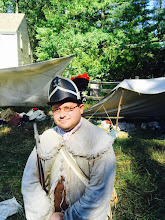
In honor of Valentine's Day, I have posted this interesting image of a married couple during the Civil War era who may have resided in Quincy, Illinois, where the photo was taken. This city is situated on the eastern banks of the mighty Mississippi River, not far upstream from the hometown of Mark Twain, Hannibal, Missouri. In 1858, coincidentally, Quincy was the site of the sixth and last legendary debates between Abraham Lincoln and Stephen Douglas. Ironically, at the time the city was a known stop on the Underground Railroad to help fugitive slaves from Missouri escape northward to Chicago.
The tallbearded gentleman in this image is wearing a fine quality frock coat with a velvet collar, and his wife looks beautiful, so I am guessing that they were well-to-do. The way she has clasped her hands is intriguing to me as well, and there are dark patches of cloth on her dress, which suggests to me the possibility she was in mourning, but that of course is pure conjecture. They look somehow sad and serious to me, despite the fact he has placed his hand on her shoulder to symbolize their special and loving relationship. On the reverse of the image is an orange 2 cent government revenue stamp, which tells us this image was taken between the summer of 1864, and August 1866, when the tax was repealed by Congress.
However, what makes this photo even more interesting is what is printed on the back:
"Mrs. W.A. Reed, Artist, No. 81 Hampshire Street, Quincy, Ills." This poignant image was produced by a female photographer, which were few and far between during the mid-nineteenth century! Reed's true identity was Candace McCormick, and she was born in Tennessee in the year 1818. In 1842, Candace married Warren Reed, and a few years later they opened a dauguerreotype gallery together in Quincy, Illinois, utlizing the first popular form of photography. Tragically her husband died about ten years later, and to help support her family, Candace opened her own studio, but keeping with the customs of the day as a widow, advertised herself under her husband's recognizable name. During the war, Mrs. Reed also served as a nurse in Union Army hospitals in Nashville and Vicksburg, certainly not an easy task. After the war, Reed continued her photography business with great success until the end of the ninteenth century, and died at the age of 82 in 1900. To see more examples of her work, please visit this website:
 I purchased this interesting image about a week ago at an antique show down in Portsmouth, NH. It is an old beat up tintype, made probably the decade immediately following the Civil War (1865-1875). The man on the left is a fairly handsome chap, with a nice felt halt, jacket and striped vest as well. It makes me think he had a little bit of money to spend, and he clearly did not do manual labor to earn his living. The younger man on the right is not dressed quite as nice, with what looks like a white linen or cotten jacket and the big poofy hat doesn't seem to fit him quite right. Yet there is something that drew my eye to this picture and captured my imagination. The two men are too close in age to be father and son, but they clearly had some sort of friendly relationship, enough to pose for a picture together that has survived over a century!
I purchased this interesting image about a week ago at an antique show down in Portsmouth, NH. It is an old beat up tintype, made probably the decade immediately following the Civil War (1865-1875). The man on the left is a fairly handsome chap, with a nice felt halt, jacket and striped vest as well. It makes me think he had a little bit of money to spend, and he clearly did not do manual labor to earn his living. The younger man on the right is not dressed quite as nice, with what looks like a white linen or cotten jacket and the big poofy hat doesn't seem to fit him quite right. Yet there is something that drew my eye to this picture and captured my imagination. The two men are too close in age to be father and son, but they clearly had some sort of friendly relationship, enough to pose for a picture together that has survived over a century!


.jpg)
.jpg)



